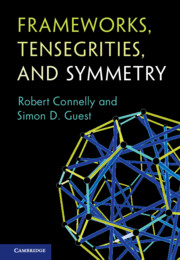
-
Select format
-
- Publisher:
- Cambridge University Press
- Publication date:
- January 2022
- January 2022
- ISBN:
- 9780511843297
- 9780521879101
- Dimensions:
- (244 x 170 mm)
- Weight & Pages:
- 0.69kg, 350 Pages
- Dimensions:
- Weight & Pages:
You may already have access via personal or institutional login
Book description
This introduction to the theory of rigid structures explains how to analyze the performance of built and natural structures under loads, paying special attention to the role of geometry. The book unifies the engineering and mathematical literatures by exploring different notions of rigidity - local, global, and universal - and how they are interrelated. Important results are stated formally, but also clarified with a wide range of revealing examples. An important generalization is to tensegrities, where fixed distances are replaced with 'cables' not allowed to increase in length and 'struts' not allowed to decrease in length. A special feature is the analysis of symmetric tensegrities, where the symmetry of the structure is used to simplify matters and allows the theory of group representations to be applied. Written for researchers and graduate students in structural engineering and mathematics, this work is also of interest to computer scientists and physicists.
Reviews
'Rigidity theory mathematicians and structural engineers are like two branches of a tribe that separated long ago. In the intervening time, the language and knowledge of each group has evolved to where concepts no longer align and common terms no longer have common meanings. As a result, when they interact today, confusion reigns. Frameworks, Tensegrities and Symmetry is a guide that both groups can use to understand the other.'
William F. Baker - Skidmore, Owings & Merrill
'The authors promise 'an attempt to build a bridge between two cultures' and they have done a remarkable job of this unenviable task. Requiring only a minimum of mathematical and engineering prerequisites the book develops intuitively, and rigorously, the rigidity theory of both bar frameworks and tensegrity frameworks and applies this theory to analyse built structures. Two masters of the field have carefully designed the book to move seamlessly between the analysis and synthesis of specific structures and providing the general, generic and symmetric theories.'
Anthony Nixon - Lancaster University
‘This excellent book unifies the engineering and mathematical literature by exploring different notions of rigidity - local, global and universal - and how they are interrelated. A lot of revealing examples accompany the mathematically precise description, hence the book can be recommended to researchers and students of mathematics, structural engineering, physics and computer science alike.’
Andras Recski Source: Mathematical Reviews
Contents
-
1 - Introduction
pp 1-6 -
-
- You have access
- Export citation
-
Metrics
Altmetric attention score
Full text views
Full text views help Loading metrics...
Loading metrics...
* Views captured on Cambridge Core between #date#. This data will be updated every 24 hours.
Usage data cannot currently be displayed.
Accessibility standard: Unknown
Why this information is here
This section outlines the accessibility features of this content - including support for screen readers, full keyboard navigation and high-contrast display options. This may not be relevant for you.
Accessibility Information
Accessibility compliance for the PDF of this book is currently unknown and may be updated in the future.


